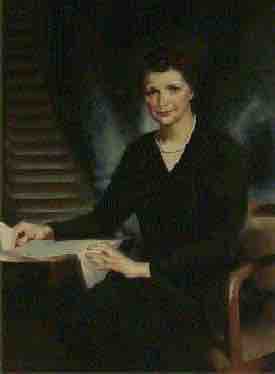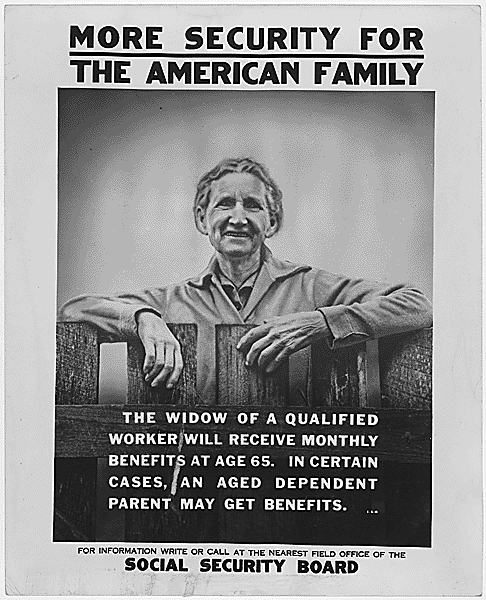BACKGROUND
Before 1935, old age insurance laws existed on the books in only several states. In reality, however, even they provided hardly any support for the elderly. The virtual absence of a system that would provide financial support for the elderly forced men and women to either work until they died or rely on families and charities. The same was largely true for other vulnerable populations that today may rely on some state support, including the disabled, single mothers, and the unemployed.
In the 1930s, the idea of state support for those in need was by no means revolutionary. It became popular in Western Europe in the second half of the 19th century and gained significant traction in the U.S. towards the end of the 19th century. However, the United States was the only major industrial country, where people faced the Great Depression without any national system of social security. Many of the First New Deal programs (1933-34/5), particularly those focused on creating jobs, offered immediate relief rather than long-term reforms. The Second New Deal (1935-38) continued the First New Deal but its programs were less a result of the earlier sense of emergency and more a reflection of bolder attitudes. After the Supreme Court declared some of the First New Deal programs unconstitutional, Roosevelt followed with an agenda that emphasized the redistribution of national wealth and the notion of social justice. In terms of what would fall under the umbrella of welfare state (in the 1930s, a more popular way to describe the phenomenon was simply "social security"), Roosevelt proposed two major ideas. First, public work programs that would offer jobs, as opposed to charity, to the unemployed. Second, direct financial support programs targeted at the most vulnerable populations.
WORKS PROGRESS ADMINISTRATION
While the First New Deal included programs that created employment in the government and through public works projects (e.g., the Tennessee Valley Authority, the Civilian Conservation Corps, the Federal Emergency Relief Administration) none of it was as large and ambitious as the 1935 Works Progress Administration (WPA). By the time WPA was disbanded in 1943, over 8.5 million people found employment at public work projects conducted under its umbrella. Roosevelt had insisted that the projects had to be costly in terms of labor, produce long-term benefit, and WPA was forbidden to compete with private enterprises, therefore the workers had to be paid smaller wages. Critics of the program noted that many jobs created under WPA were not essential or even necessary, but its supporters consistently emphasized that creating opportunities for the unemployed, as opposed to providing for them in cash or in kind, was invaluable.
As a result of WPA, 650,000 miles of highways and roads, 125,000 public buildings (hospitals, schools, etc.), bridges, reservoirs, irrigation systems, parks, and playgrounds were built. Prominent projects include the Lincoln Tunnel, the Robert F. Kennedy Bridge, the LaGuardia Airport, the Overseas Highway, and the San Francisco Oakland Bay Bridge.
Also under WPA, a number of additional programs offered opportunities targeted at specific populations. The National Youth Administration focused on providing education and work for Americans between the ages of 16 and 25. Its Texas director, Lyndon B. Johnson, later used NYA as a model for some of his Great Society programs in the 1960s. The Federal Project Number One created jobs for writers, musicians, artists, and theater personnel. Under the Federal Writer's Project, writers cataloged archives, documented folklore, and collected what today would be labeled as oral histories. In what remains one of the most controversial projects of the time, former slaves were interviewed and their stories were recorded. Under the Federal Theater Project, actresses and actors, technicians, writers, and directors were able to produce plays. Inexpensive or free tickets made theater available to the masses, including the audiences that usually would not attend stage productions. Female artists were asked to paint murals or create statues for newly built post offices and courthouses. Many of these works of art can still be seen in public buildings around the country, along with murals sponsored by the Treasury Relief Art Project of the Treasury Department.
The public utility of projects carried under WPA cannot be overestimated. Essential infrastructure grew in urban and rural areas that were also revitalized and beautified. However, the program did not fix or even address the causes of the devastating unemployment that was such a huge aspect of the Great Depression. Neither did it provide an answer to how to secure economic stability and prevent similar disasters in the future. Finally, WPA embraced and deepened existing gender inequalities by offering very limited opportunities to women. As the program stipulated that only one family member could benefit from public employment, the jobs would usually go to men who traditionally served the role of breadwinners. Moreover, men were seen as a more "natural" fir for WPA jobs since most of them were conventionally associated with male labor force (most notably, in the construction sector).
SOCIAL SECURITY ACT
Perhaps the most important and influential program of the New Deal was the 1935 Social Security Act (SSA). It was drafted by Francis Perkins - the Secretary of Labor in the Roosevelt administration and the first woman serving in the U.S. cabinet. The Act established a permanent system of retirement pensions (Social Security), unemployment insurance, and welfare benefits for the handicapped and needy children in families without father present (the latter under the program known as the Aid to Dependent Children, ADC). Although it is important to keep in mind that the SSA benefits did not cover all Americans falling into the categories included in the document, it was the first time when the federal government took responsibility for the economic security of the aged, the temporarily unemployed, dependent children, and the handicapped.

Frances Perkins, fourth U. S. Secretary of Labor
Frances Perkins drafted the Social Security Act
Compared with the social security systems in western European countries, SSA was rather conservative. Its original version (amended later) also endorsed and deepened racial and gender inequalities in the United States. Perkins' original draft was much more ambitious than the eventual document passed in Congress as she intended to include nearly all workers in the old age pension benefits. However, the balance of power in Congress resulted in a compromised version that excluded rural and domestic workers. This stipulation affected many Americans but no other group more than African Americans and particularly African American women. Out of the latter group, the overwhelming majority of those who met the age requirement (65 or older), did not qualify for the pension because of their earlier employment in agriculture or domestic service. Also under ADC, it was primarily white mothers who received support as historically, black mothers were usually part of the labor force and were deemed ineligible for the ADC benefits. However, under the same program, many poor white mothers faced the moral judgement of their middle and upper class compatriots who decided that wile some women deserved the support, other did not.

More Security for the American Family
A poster advertising Social Security during the New Deal Era
TAX REFORM
Roosevelt insisted that SSA should be funded by payroll taxes, rather than from the general fund "so as to give the contributors a legal and political right to collect their pensions and unemployment benefits." He added, "With those taxes in there, no damn politician can ever scrap my social security program." This idea was what at the time distinguished the old-age pension program from similar programs offered in Western Europe.
In 1935, Roosevelt called for a tax program called the Wealth Tax Act (Revenue Act of 1935) to redistribute wealth. The bill imposed a progressive income tax (the higher the income, the higher the tax rate) on corporations and rich individuals, with as high a rate as 75% on individual incomes over $5 million. This highest tax rate covered just one individual, John D. Rockefeller. The bill was expected to raise only about $250 million in additional funds, so revenue was not the primary goal. It raised the bitterness of the rich, who called Roosevelt "a traitor to his class."
In 1936, Roosevelt also pushed for a tax on undistributed corporate profits. This time the primary purpose was revenue, since Congress had enacted the Adjusted Compensation Payment Act, calling for payments to World War I veterans of $ 2 billion. The bill established the persisting principle that retained corporate earnings could be taxed. Paid dividends were tax deductible by corporations. The purpose was to stimulate corporations to distribute earnings and thus put more cash and spending power in the hands of individuals. The business community fervently criticized the proposal. In the end, Congress responded to the criticism by setting the tax rates at 7 to 27% and largely exempting small enterprises.